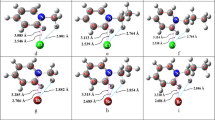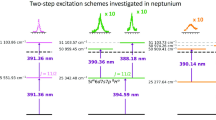Abstract
The spatial and electronic structure and absorption spectra of butyllithium, 1-phenylpropyllithium, and 1,1-diphenylpropyllithium and their anionic and radical forms are calculated. Ionization potentials are low (about 6 eV) for all the organolithium compounds. The low-frequency electron transition in the visible range of the spectra of aromatic organolithium compounds is due to the electron density transfer from the α-carbon atom to the aromatic rings. Complexes of 1,1-diphenylpropyllithium with methylbenzoate and acetophenone, possessing low electron affinity (0.92 and 0.9 eV), are considered It is assumed that thermal electron transition occurs in the excited triplet state of the complex and is accompanied by a removal of the Li+ cation. A comparison of the experimental spectrum of the polystyryl-l,l-diphenylethyllithium+methylbenzoate reaction system with the calculated spectra of the MB.-and AP.-radical onions and MB.Li and AP.Li radicals showed that the best agreement is observed for AP.Li.
Similar content being viewed by others
References
M. Schwartz,Anion Polymerization [Russian translation], Mir, Moscow (1971).
V. Zgonnik, E. Melenevskaya, J. Kever, et al.,Macromol Chem. Phys.,196, 85–98 (1995).
O. Yu. Okhlobystin,Electron Transfer in Organic Reactions [in Russian], Rostov University Press, Rostov-on-Don (1974).
K. K. Kalninsh and A. F. Podolskii,High-Molecular Compounds,33A, No. 10, 2215–2224 (1991).
K.K. Kalninsh,Chem. Phys. Lett.,79, No. 3, 427–430 (1981).
A. V. Ilyasov, Yu. M. Kargin, and I. D. Morozova,ESR Spectra of Organic Radical Ions [in Russian], Mir, Moscow (1980).
E. Anders, R. Koch, and P. Freunscht,J. Comput. Chem.,14, No. 11, 1301–1312 (1993).
K. K. Kalninsh, A. F. Podolskii, A. D. Kutsenko, and S. G. Semenov,High-Molecular Compounds,32A, No. 2, 316–321 (1990).
V. N. Kondratiev (ed.),Chemical Bond Cleavage Energies. Ionization Potentials and Electron Affinities, Nauka, Moscow (1974).
K. K. Kalninsh,J. Chem. Soc., Faraday Trans.,77, No. 2, 227–238 (1981).
Author information
Authors and Affiliations
Additional information
Translated from Zhurnal Struktumoi Khimii, Vol. 38, No. 1, pp. 59–67, January–February, 1997.
Rights and permissions
About this article
Cite this article
Kalninsh, K.K. Quantum chemical treatment of the structure and absorption spectra of 1,1-diphenylpropyllithium and its complexes. J Struct Chem 38, 47–53 (1997). https://doi.org/10.1007/BF02768806
Received:
Issue Date:
DOI: https://doi.org/10.1007/BF02768806




